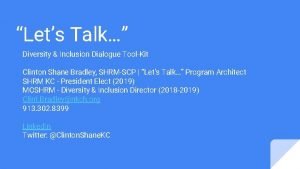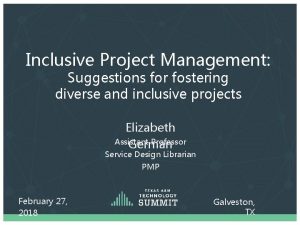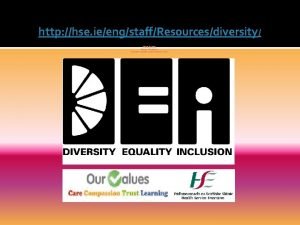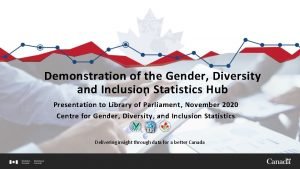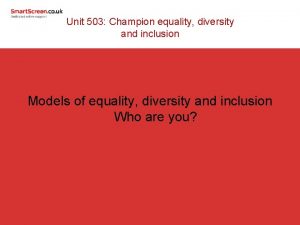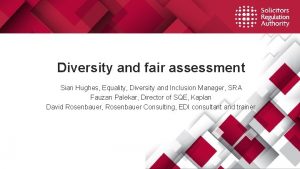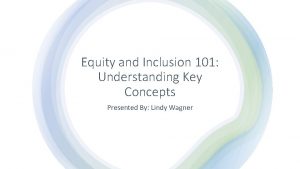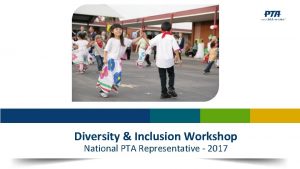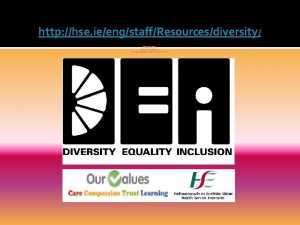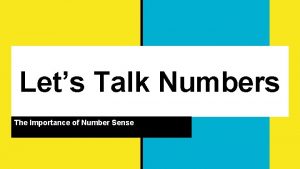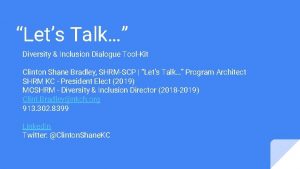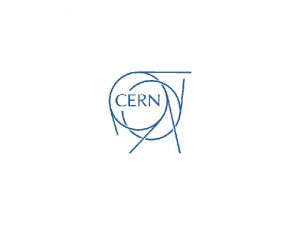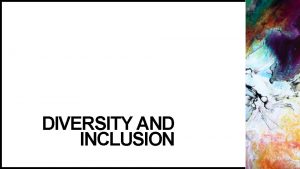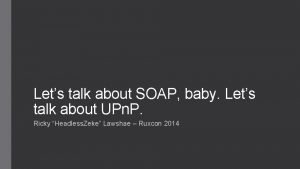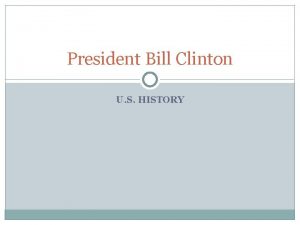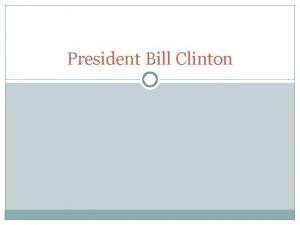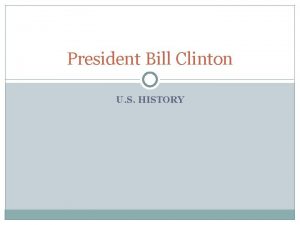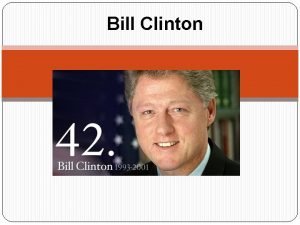Lets Talk Diversity Inclusion Dialogue ToolKit Clinton Shane














- Slides: 14

“Let’s Talk…” Diversity & Inclusion Dialogue Tool-Kit Clinton Shane Bradley, SHRM-SCP | “Let’s Talk…” Program Architect SHRM KC - President Elect (2019) MOSHRM - Diversity & Inclusion Director (2018 -2019) Clint. Bradley@nkch. org 913. 302. 8399 Linked. In Twitter: @Clinton. Shane. KC

“Let’s Talk. . . History” In 2016 SHRM of Greater Kansas City Diversity & Inclusion Committee started an after-hours story share by inviting an individual within the community to come and share their story. Each story had a unique Diversity & Inclusion theme. The after-hours group started out small with only the committee and a few SHRM KC members. The first story share was about an executive’s transition from male to female while working in the c-suite. This compelling story allowed an opportunity for our members to ask questions, inquire and learn about how to create better practices for transgender in the workplace. Since that first after-hours event, SHRM KC has coordinated many other dialogues including: Transgender; Veterans & Servicemembers; Disability; Religion; Race; Gender. Our event participation continues to grow as we’ve reached up to eighty in attendance.

“Let’s Talk. . . Purpose” Being able to dialogue with other HR Professionals helps us grow in our knowledge and expertise. There are times, unfortunately, we don’t know what we don’t know to understand the full inclusion of diversity within our organizations. Having the right dialogues can help: ● ● Prevent workplace disruptions by identifying area/s of weakness or blindspots. Implement proactive measures to prevent costly complaints. Allow a safe space to share ideas; concerns; fears; questions. Create a culture of openness and understanding.

“Let’s Talk. . . How to Begin” In the beginning, it might seem a little overwhelming. Hopefully, this tool-kit can provide a step-by-step approach on implementing a “Let’s Talk…” program for your chapter. The following items are a good place to start: ● Determine if there is a current need for your chapter to begin a dialogue program. ● Acquire the buy-in from chapter board/volunteer leadership by providing the purpose. ● Ensure dialogue program aligns to chapter vision & purpose. ● Develop a dedicated Diversity & Inclusion Volunteer Committee.

“Let’s Talk. . . Challenges” Starting a dialogue program such as this one does present some unique challenges. The following items are some of the more common challenges we’ve managed through. ● ● ● Are members open to these types of dialogues? Beginning a dialogue program doesn’t mean everyone is going to be comfortable with all themes/topics. Working with your chapter board to gauge the needs of your membership with the right theme/topic is very important. Our chapter dialogues began in a very organic way. However, we also put out surveys, and encouraged one-on-one conversations to determine membership wants and needs. A caring approach to understanding the journey. Diversity & Inclusion is a journey. Each individual may be at a different level of understanding that journey. Be sure your dialogue topics are directly linked to the workplace. It’s very important to have a volunteer chair who is patient and understanding to everyone’s needs and concerns. What’s the purpose? It’s always important to present the purpose to your membership and volunteer leadership. If it helps, please refer back to the purpose, and what our chapter has developed from the beginning

“Let’s Talk. . . Dialogue Themes” SHRM KC has created a number of unique and fun approaches to our dialogues. Be as creative as possible, but ensuring the alignment to your chapter goals, guidelines and membership needs. It’s highly recommended to align with current workplace trends/topics. These are just some examples of our dialogue topics/themes: ● ● ● Story Share: An individual is invited to share their unique workplace story. There is a time available after the story for Q&A. Round Table Dialogue: Split up into groups of 3 -5. Have a set of questions pertaining to the particular topic. Facilitator presents the question, allows for small group discussion, then open group discussion. Panel Discussion: Invite subject matter experts to serve on a panel with Q&A. We invited a panel of experts to our religion in the workplace dialogue: Muslim; Christian; Jewish. Lecture Presentation: Invite a subject matter expert to present on a particular theme (lecture), then open up for Q&A. We coordinated a subject matter expert dialogue on “Gender Equity. ” Speed Dialogue: This is a “speed-dating” style dialogue. Provide a list of diversity & inclusion scenarios in the workplace. Attendees will pair up, quickly discuss/mitigate the scenario, then rotate to the next.

“Let’s Talk. . . When” Our chapter has found the best time for the dialogues has been after-hours. Each chapter is different, and it is important to discuss with your volunteer leadership, or committee, on appropriate times. Here is the agenda we currently follow: ● ● ● 5: 30 pm-6: 00 pm (registration/welcome & networking) 6: 00 pm-7: 00 pm (dialogue) 7: 00 pm-7: 30 pm (open discussion or group Q&A) Our chapter is currently implementing our dialogues quarterly (Winter; Spring; Summer; Fall). However, it is recommended to start out with just a couple for the year, gauge membership participation, then determine if additional dialogues are needed.

“Let’s Talk. . . Where” Getting the right dialogue sponsor (employer or organization) is a key component. We’ve had a diverse group of sponsors, from banking to engineering, and a museum, who have graciously allowed us to use their spaces. The following is what we ask of our sponsors: ● ● ● Provide a space large enough to hold up to 50 participant/attendees. Provide after-hours drinks & food. We’ve had sponsors provide everything from an open-bar and appetizer table to light snacks and beverages. Allow your sponsor to determine their capabilities. If serving alcohol, please be sure to check chapter and sponsor guidelines on liability. Be present. We encourage sponsors to invite their HR Team & Leadership to participate in the dialogue.

“Let’s Talk. . . Facilitating” Acquiring the right facilitator can make or break a dialogue. It is crucial that each facilitator is a subject matter expert for the planned dialogue theme/topic. Here is how you can find/acquire a facilitator: ● ● Tap into your networks. Ask your volunteer leadership or committee if they know of someone. Connect w/an employer/organization with a diversity & inclusion program. Connect w/a non-profit who specializes in a particular topic (i. e. veterans groups; disability advocacy groups; lgbt centers; women’s foundation).

“Let’s Talk. . . Attendance” Dialogue attendance has ranged from half a dozen, and up to as many as eighty. No matter how small, or how large, each dialogue has provided great purpose for each of our members and participants. The following provides a brief outline of our dialogue attendance & guidelines: ● Chapter members (cost is free) ● Sponsor (cost is free) ● Non Chapter Members (cost is $25 goes towards chapter membership if they decide to join). Discuss with your chapter leadership on appropriate cost and attendance requirements.

“Let’s Talk. . . Pre Dialogue” Ensuring the right tone for a particular dialogue topic/theme is very important. If you’re doing a panel discussion, or speed round dialogue, try sending out a communication to participating members allowing them to provide dialogue specific questions prior to the event. This can help the facilitator or subject matter expert better prepare for the dialogue. Also, send out a standard email to participants that sets the dialogue tone, guidelines & expectations. The next slide is an email example.

“Let’s Talk. . . Pre Dialogue Email” We want to help everyone participating in this dialogue prepare mentally with respect, understanding, empathy and openness. We want to encourage effective collaboration with other HR Professionals, Practitioners and Consultants by: demonstrating nonjudgmental respect for others’ perspectives; possessing self-awareness and humility in order to learn from others; and appreciating the commonalities, values and individual unique attributes of all human beings. Opening up a diversity dialogue such as this one supports inclusion efforts, and can translate into new ideas and thought processes that can help solve workplace challenges and enhance our organizations as a whole. So, as HR colleagues and friends, please view over these three great tips from author, Allison Manswell. ● Seek to understand. All of us have experience-tinted lenses that affect how we perceive the world. The key, therefore, is to look outside of what we think we know and what we have experienced and to try to understand things from others' perspectives. We must also learn to recognize verbal and nonverbal cues indicating that someone might have taken offense to something that was said. ● Be willing to engage and be vulnerable. If you aren't sure what to say in a particular situation, simply tell the other person that. Showing vulnerability encourages others to do so as well. ● Accept responsibility for becoming part of the solution. Individually we may not be responsible for the awkwardness in certain situations, but collectively we can acknowledge the part we have played and agree to work together toward a solution. Stepping out of your comfort zone to speak on issues surrounding diversity can be a daunting task. But, deciding to engage in a productive manner will have a greater impact on workplace relationships than neglecting to do so. Taking that leap is a great opportunity to set the tone for inclusion throughout your organization—and a learning experience to take with you throughout life.

“Let’s Talk. . . Post Dialogue” Implementing a post dialogue follow up is very important in order to stay connected with your members’ needs, and to measure the importance of the dialogue. Construct a follow up email to go out immediately following the dialogue to all registered participants that includes a survey link. Survey Link: We’ve used both Survey Monkey and Jot. Form.

“Let’s Talk…Questions” Diversity & Inclusion Dialogue Tool-Kit Clinton Shane Bradley, SHRM-SCP | “Let’s Talk…” Program Architect SHRM KC - President Elect (2019) MOSHRM - Diversity & Inclusion Director (2018 -2019) Clint. Bradley@nkch. org 913. 302. 8399 Linked. In Twitter: @Clinton. Shane. KC
 Let's talk clinton
Let's talk clinton Diversity and inclusion scorecard
Diversity and inclusion scorecard Korn ferry diversity and inclusion maturity model
Korn ferry diversity and inclusion maturity model Hse diversity equality and inclusion strategy
Hse diversity equality and inclusion strategy Centre for gender diversity and inclusion statistics
Centre for gender diversity and inclusion statistics Diversity and inclusion training objectives
Diversity and inclusion training objectives Champion equality diversity and inclusion
Champion equality diversity and inclusion Diversity and inclusion consulting
Diversity and inclusion consulting Dei pulse survey
Dei pulse survey Diversity equity and inclusion 101
Diversity equity and inclusion 101 Pta diversity and inclusion
Pta diversity and inclusion Centre for gender diversity and inclusion statistics
Centre for gender diversity and inclusion statistics Hse diversity equality and inclusion strategy
Hse diversity equality and inclusion strategy Let's talk about sport
Let's talk about sport Let's talk about numbers
Let's talk about numbers
